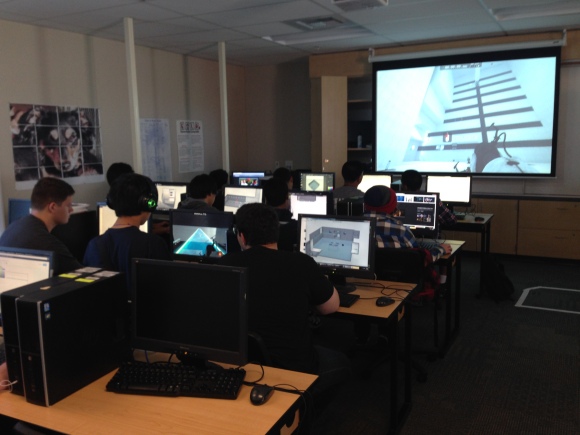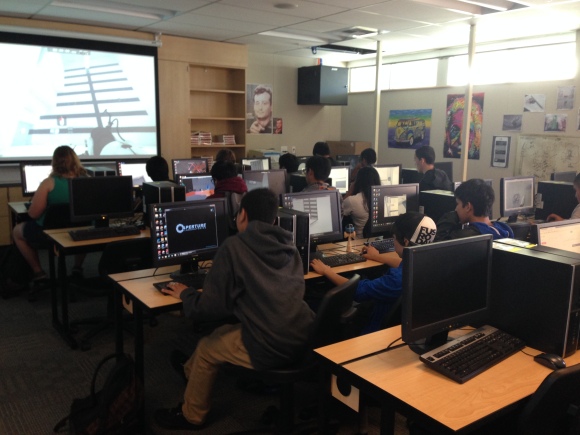Teachers aren’t the only people trying to get Portal 2 into classrooms. It’s only natural that students too are pressuring their teachers and schools to try out video games in the classroom. One 11th grade student, Daniel Verlaque, was instrumental in bringing Portal 2 to physics classes at his school. And students at other schools need to thank Daniel, too, for providing technical support to Portal 2 educators around the world on Valve’s Portal 2 teacher forum!
I’ve been impressed by how hard Daniel has been working to get teachers to try Portal 2, so last week, I sent him a few questions about his thoughts on using video games as teaching tools. Here is part 1 of his (slightly edited) responses.
………………………..
How did your interest in teaching and learning with Portal 2 begin?
I’d never even heard of
Portal until
Portal 2 came out. One of my friends kept telling me about it, which interested me, but my mother had always been set against video games, so I never thought I’d get it. However, she happened to read a
New York Times article that convinced her to let me buy the game. I instantly fell in love with
Portal 2 and became a huge
Portal fan.
Fast-forward a bit, to the beginning of the 2012-2013 school year–and my first high school Physics class. My Physics teacher is a very friendly guy who likes technology and actually wrote his thesis on using video games in classrooms. When I asked him if he’d ever played
Portal 2, he said that he had, but he didn’t seem to think that we could play it in class because of cost and deployment issues. However, when I came across the
teachwithportals website and discovered that
Portal 2 was actually
free for school use, he said that he’d love to give it a shot, as long as the tech department was OK with it. Over the next few months, I demonstrated
Portal 2 (and
Universe Sandbox 2, which was also available through Steam for Schools) to the tech department and then worked with them to deploy and test the software. Despite some obstacles, we eventually managed to get
Portal 2 and
Universe Sandbox 2 installed on all of our science department’s laptops.
Which classes are using Portal 2 [at your school]? Are students learning with any other video games at your school? How are classes that use video games different than traditionally taught classes?
At the moment, Portal 2 is not a widely used program at my school, in large part because it was only deployed halfway through the school year. My teacher’s classes played Universe Sandbox and Portal 2, but none of the other teachers have used them because they are not yet familiar with them. I will probably show the rest of the physics teachers how the programs work sometime in the near future so that they can decide how to incorporate them into their classes.
We played Universe Sandbox in January, at the end of our unit on gravity. Although we didn’t actually use it to learn the material (simply because the curriculum had been planned without Steam for Schools in mind), we did get to play it after the test, while the concepts were still fresh in our minds. It was really quite a lot of fun to watch the other students play Universe Sandbox for the first time and see the concepts they’d been learning from a blackboard come to life in a 3D virtual universe. I’d first played Universe Sandbox several months before we even learned about gravity, so it was especially interesting for me to see how my own understanding of the physics behind the game changed.
If you were teaching [insert any subject here], how would you teach with Portal 2 or other video games?
I’m going to stick to what I know–Portal 2 and Universe Sandbox in Physics–and say that I would use them to help demonstrate concepts to students and (when appropriate) use them to replace some of the labs we do in class. Instead of just drawing something like projectile motion on a blackboard and leaving it at that, I’d show the students what the concepts look like in an immersive 3D world. Universe Sandbox is especially interesting, as it’s really impossible to model a system of that scale in a lab experiment. When we learned about gravity, we were limited to drawings on the blackboard and a few (very simple) online animations. But with Universe Sandbox, a teacher can have his or her students actually understand what would happen if, for example, the Earth’s mass was changed to equal that of the Sun, or what would happen to Saturn’s rings if another planet got too close. These are things that you really can’t demonstrate on a blackboard. With something like projectile motion, you can at least draw a parabola on the board–which still pales in comparison to something like Portal 2, but at least you can do something–but there’s simply no way you can draw Saturn’s rings being ripped away by a rogue planet or a collision between two galaxies.
What advice would you give to educators who want to teach with Portal 2 or other video games?
The most practical advice I can give to educators is that they should try to avoid rushing into the setup stage. Make sure your IT department is on board and you have a good idea of what you’re trying to do. You’ll run into obstacles, but don’t get discouraged–there are lots of people who are willing to help you out!


